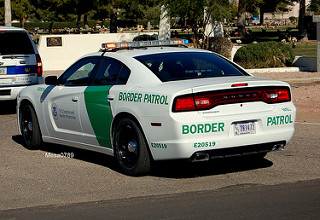clear
What % of illegal drugs are trafficked via the U.S.-Mexico border?
clear

source:
Mesa0789 / Flickr
Let's talk about Mexico’s involvement in the illicit drug trade in the United States in numbers and specifications :
US and Mexico, called the Southwestern border or SWB.Drug cartels in Mexico utilize drug mules, tunnels, boats, vehicles, trains, aircrafts, donkeys, and couriers to get illegal drugs into America. Mexican drug cartels make an estimated $19-$29 billion a year on drug sales in the United States. Conflicts between drug cartels over territory as well as the attempts to stop drug trafficking by law enforcement officials often results in violence, and this has caused over 55,000 deaths since the proclaimed Mexican Drug War began in 2006.
Marijuana: Mexico is the number one foreign supplier of marijuana to the United States, and marijuana is thought to be the top revenue generator for Mexican drug cartels.
Cocaine: Mexico does not produce cocaine, however, Mexican cartels move Columbian cocaine through South and Central America and into the United States. An estimated 93 percent of cocaine headed to the US from South America moves through Mexico.
Methamphetamine: Mexico remains the biggest foreign supplier of methamphetamine to the United States, and Mexican drug cartels set up labs to manufacture meth on both sides of the border, controlling labs in Southern California as well as domestically.
Heroin: While Asia and the Middle East remain the biggest producers of heroin, Mexican black-tar and brown heroin is on the rise. In fact, 39 percent of heroin identified under the DEA’s Heroin Signature Program (HSP) in 2008 came from Mexico, making Mexico the source country for many of the heroin abusers west of the Mississippi River.
 0
0
clear
 Wafa Benizid
6 years, 11 months ago
Wafa Benizid
6 years, 11 months ago
The illegal drug market in the United States is one of the most profitable in the world. As such, it attracts the most ruthless, sophisticated, and aggressive drug traffickers. Drug law enforcement agencies face an enormous challenge in protecting the country's borders. Each year, according to the U.S. Customs Service, 60 million people enter the United States on more than 675,000 commercial and private flights.
Another 6 million come by sea and 370 million by land. In addition, 116 million vehicles cross the land borders with Canada and Mexico. More than 90,000 merchant and passenger ships dock at U.S. ports. These ships carry more than 9 million shipping containers and 400 million tons of cargo. Another 157,000 smaller vessels visit our many coastal towns. Amid this voluminous trade, drug traffickers conceal cocaine, heroin, marijuana, MDMA, and methamphetamine shipments for distribution in U.S. neighborhoods.
Diverse groups traffic and distribute illegal drugs. Criminal groups operating from South America smuggle cocaine and heroin into the United States via a variety of routes, including land routes through Mexico, maritime routes along Mexico's east and west coasts, sea routes through the Caribbean, and international air corridors. Furthermore, criminal groups operating from neighboring Mexico smuggle cocaine, heroin, methamphetamine, amphetamine, and marijuana into the United States. These criminal groups have smuggled heroin and marijuana across the Southwest Border and distributed them throughout the United States since the 1970s.
In addition to distributing cocaine and methamphetamine in the West and Midwest, these Mexico-based groups now are attempting to expand the distribution of those drugs into eastern U.S. markets.
 0
0
clear